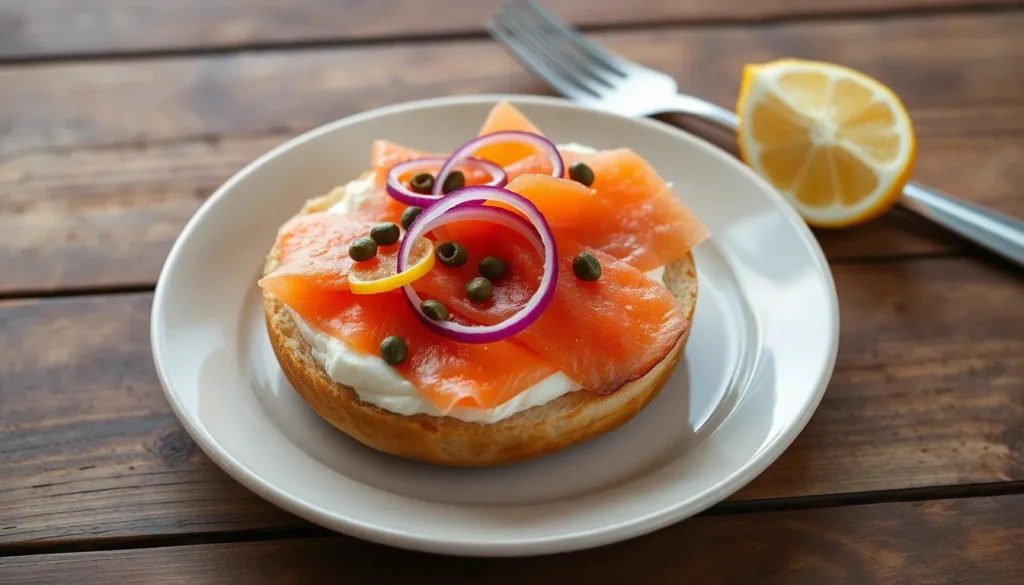Nothing beats the rich smoky flavor and tender texture of perfectly prepared smoked fish. We’ve discovered that these protein-packed delicacies transform ordinary meals into extraordinary culinary experiences that’ll have your taste buds dancing with delight.
Whether you’re working with salmon, trout, mackerel, or any other smoked variety, we’re about to show you how to create restaurant-quality dishes right in your own kitchen. From elegant appetizers that impress dinner guests to hearty main courses that satisfy the whole family, smoked fish offers endless possibilities for creative cooking.
Ready to elevate your cooking game? We’ve compiled our favorite smoked fish recipes that’ll turn you into the chef everyone talks about. These dishes aren’t just delicious – they’re surprisingly simple to master and perfect for both weeknight dinners and special occasions.
Classic Smoked Salmon Bagel with Cream Cheese
We consider this iconic combination the gold standard of smoked fish appetizers that transforms a simple breakfast into an elegant dining experience.
Traditional New York Style Preparation
Split your everything bagel in half and toast it until golden brown for the perfect texture contrast. Spread a generous layer of cream cheese on both halves, creating a smooth base that complements the salmon’s richness. Layer thin slices of premium smoked salmon across the cream cheese, allowing the fish to drape naturally without overlapping. Add paper-thin red onion slices for a sharp bite that cuts through the richness. Place fresh capers on top to provide bursts of briny flavor that enhance the salmon’s smokiness. Finish with a light sprinkle of freshly cracked black pepper and a squeeze of lemon juice to brighten the entire dish.
Garnish and Topping Variations
Elevate your bagel with thinly sliced cucumber rounds for added crunch and freshness. Experiment with different cream cheese flavors like dill, chive, or garlic herb to create unique taste profiles. Try avocado slices as a creamy alternative that pairs beautifully with the salmon’s texture. Consider adding fresh dill sprigs or chopped chives for an aromatic herb finish. Swap traditional capers for pickled mustard seeds or cornichons for interesting flavor variations. Include sliced hard-boiled eggs for extra protein and a classic Jewish deli touch. Drizzle high-quality olive oil or everything bagel seasoning for additional depth and visual appeal.
Smoked Trout Salad with Mixed Greens

Building on our smoked fish journey, we’re diving into one of the most refreshing ways to enjoy smoked trout. This elegant salad combines the rich, smoky essence of trout with crisp, fresh greens to create a perfectly balanced dish that works beautifully as a light lunch or sophisticated starter.
Selecting the Perfect Smoked Trout
Rainbow trout stands out as our top choice for smoked fish salads due to its mild, delicate flavor profile. This variety’s naturally oily texture allows it to absorb smoke exceptionally well, creating that sought after depth of flavor we’re looking for in our salads.
Hot smoked trout offers the ideal texture for salad applications since it’s fully cooked during the smoking process. The result is a soft, flaky consistency that breaks apart beautifully when tossed with greens and dressing.
Cold smoked trout provides a silky, more delicate texture that’s perfect for dishes where you want the fish to maintain its structure. We recommend this option when you’re creating more elegant presentations or serving the trout as a focal point.
Quality indicators help us choose the best product every time. Look for trout that displays an attractive reddish pink color without any grayish spots, which signals both freshness and proper smoking technique.
Proper brining makes all the difference in flavor development. The best smoked trout comes from fish that’s been brined using kosher salt and brown sugar, creating that perfect balance of seasoning and smoke infusion we want in our salads.
Complementary Dressing Options
Lemon Dill Vinaigrette creates the perfect bright counterpoint to smoky trout flavors. We combine fresh lemon juice, olive oil, chopped dill, a touch of honey, salt, and pepper to enhance the fish’s natural taste without overwhelming it.
Mustard Honey Dressing delivers a sweet and tangy balance that cuts through the richness of smoked trout beautifully. Mix Dijon mustard, honey, olive oil, and apple cider vinegar for a dressing that adds complexity to every bite.
Creamy Dill Sauce provides a cooling contrast that mellows the intensity of smoked fish. We blend sour cream or Greek yogurt with fresh dill, lemon juice, and a hint of garlic to create a luxurious coating for our salad ingredients.
Citrus Vinaigrette highlights the trout’s natural flavors using orange or grapefruit juice combined with olive oil and a pinch of salt. This lighter option works particularly well when we want the fish to remain the star of the dish.
Smoked Mackerel Pâté with Horseradish
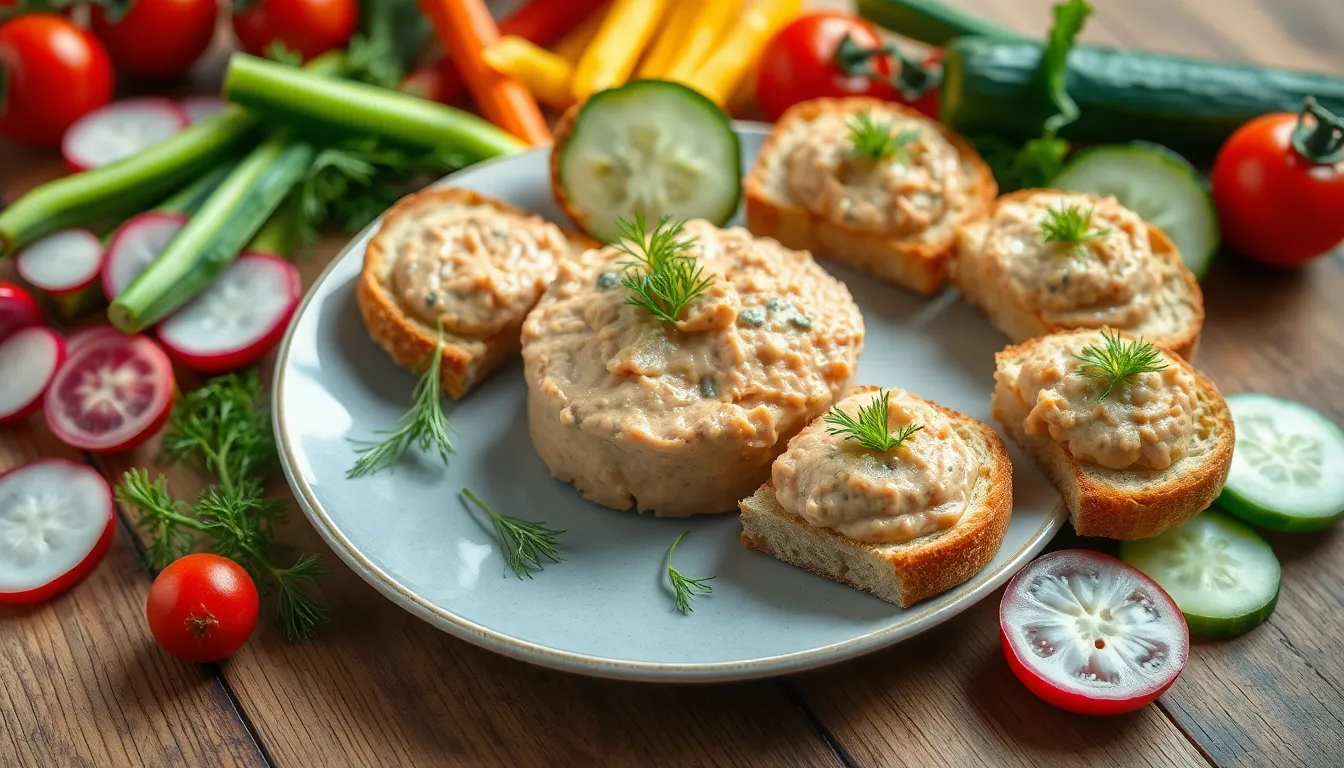
Building on our smoked fish journey, we’re diving into another sophisticated appetizer that transforms simple ingredients into an elegant dish. This pâté combines the rich, oily texture of smoked mackerel with the sharp bite of horseradish for an irresistible flavor profile.
Essential Ingredients for Authentic Flavor
Smoked mackerel fillets form the foundation of this dish, requiring 200-250 grams with skin carefully removed for the smoothest possible texture. Premium fillets ensure the pâté develops that characteristic smoky depth we’re aiming for.
Mayonnaise provides essential creaminess using 3 tablespoons, though cream cheese works as an excellent alternative for those preferring a richer base. Either option creates the perfect binding consistency for our pâté.
Horseradish cream or freshly grated horseradish delivers the signature kick using 1-2 tablespoons depending on your heat preference. Fresh horseradish offers more intense flavor, while prepared horseradish cream provides consistent results.
Lemon juice brightens the entire mixture with acid from 1/4 to 1/2 lemon, balancing the rich fish oils and preventing the pâté from tasting heavy. Fresh lemon juice always outperforms bottled versions in this application.
Spring onions contribute mild onion flavor using only the green parts, finely chopped to maintain the pâté’s smooth texture while adding fresh notes. Traditional white onions would overpower the delicate mackerel.
Salt and black pepper season to taste, improving all the other flavors without masking the fish’s natural smokiness. Optional fresh dill adds aromatic complexity for those wanting extra herbal notes.
Serving Suggestions and Accompaniments
Elegant starter presentation showcases the pâté spread on lightly toasted sourdough or baguette slices, creating a refined appetizer perfect for dinner parties or special occasions. Toasting the bread prevents sogginess while adding textural contrast.
Dip applications transform the pâté into a crowd pleasing option using toasted pita bread or crisp crackers as vehicles, making it ideal for casual gatherings or party platters. Guests can control their own portions this way.
Sandwich applications elevate lunch preparations by spreading the pâté inside sandwiches with fresh salad leaves, creating protein rich meals that satisfy without feeling heavy. This works particularly well with crusty rolls or artisan breads.
Meal toppers expand serving options by spooning the pâté over baked sweet potatoes, jacket potatoes, or fresh mixed greens for light yet satisfying meals. These combinations highlight the pâté’s versatility beyond traditional appetizer roles.
Picnic presentations pair beautifully with oatcakes or crackers, complemented by fresh vegetables like radishes, cucumber, and cherry tomatoes for variety and crunch. This combination provides textural contrast while keeping flavors balanced.
Smoked Haddock Chowder

Moving beyond cold preparations, we’ll explore how smoked haddock transforms into a warming, soul-satisfying chowder that’s beloved along Scotland’s coast and throughout New England.
Building the Perfect Creamy Base
Starting with the foundation, we recommend using bacon or smoked bacon fat as our flavor base since it adds an extra layer of smokiness that complements the haddock beautifully. Cooking the bacon gently releases its fat, which we’ll use to sauté our aromatic vegetables until they become translucent and fragrant.
Incorporating small diced potatoes comes next, preferably new potatoes that hold their shape during simmering while contributing to the chowder’s hearty texture. These potatoes create natural thickening as they cook, giving our chowder that satisfying, substantial feel we’re after.
Building our liquid foundation requires a thoughtful combination of milk and heavy cream to achieve the perfect richness and smoothness. Adding clam stock or fish stock enhances the seafood flavor profile, creating deeper umami notes that elevate the entire dish beyond a simple cream soup.
Balancing the seasoning involves bay leaves, fresh thyme, salt, and pepper to enhance the complex flavor layers without overwhelming the delicate smoked fish. We’ll simmer these ingredients together until the vegetables become tender and the flavors meld into a cohesive, creamy base.
Vegetable Additions and Seasonings
Choosing leeks and onions provides the essential sweetness and aromatic foundation that every great chowder needs. We’ll sweat these vegetables gently in our bacon fat until they release their natural sugars and become soft.
Adding celery introduces subtle savory notes and provides textural contrast to the creamy base. The celery’s mild flavor doesn’t compete with the smoked haddock but rather supports and enhances the overall taste profile.
Incorporating fresh corn creates a delightful sweet contrast to the smoky fish, as demonstrated in Clodagh McKenna’s variation of smoked haddock and corn chowder. The corn kernels add pops of color and natural sweetness that brighten each spoonful.
Finishing with fresh herbs like parsley and thyme brings brightness and freshness to the rich, creamy chowder. We’ll add the parsley at the very end to preserve its vibrant color and fresh flavor, while thyme gets added earlier to infuse throughout the cooking process.
Timing the smoked haddock addition is crucial since we want to warm it through without overcooking the delicate fish. Adding the diced smoked haddock during the final minutes of cooking preserves its texture and prevents it from becoming tough or stringy.
Smoked Salmon Pasta with Dill and Capers
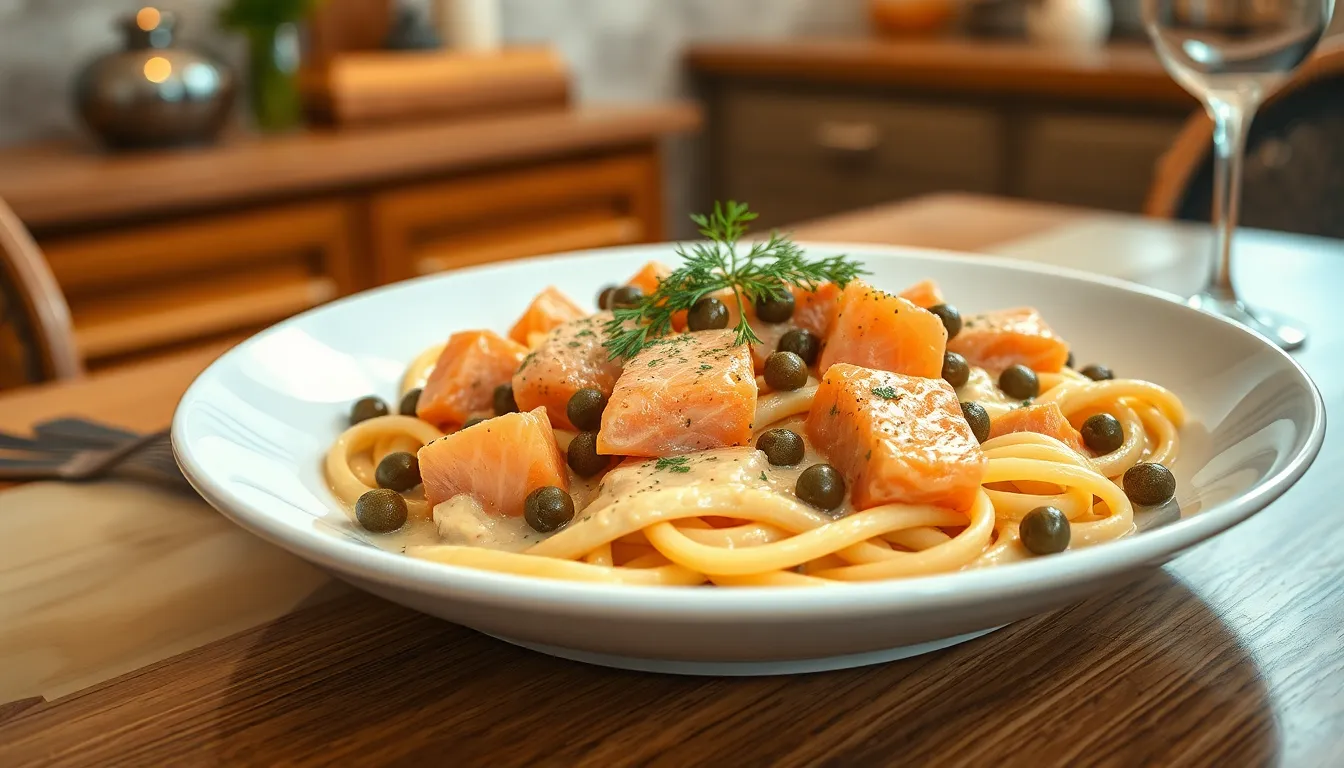
Elevating our smoked fish repertoire with a sophisticated main course, this luxurious pasta dish combines tender smoked salmon with aromatic dill and briny capers in a silky cream sauce.
Choosing the Right Pasta Shape
Selecting the perfect pasta shape transforms this dish from good to exceptional. Long, thin varieties like fettuccine, linguine, and tagliatelle work beautifully because they allow the cream sauce to coat each strand evenly while the dill and capers cling naturally to their surfaces.
Wide ribbon pastas create an elegant presentation that showcases the pink salmon pieces nestled between silky strands. Shorter shapes offer their own advantages, with penne and farfalle trapping bits of smoked salmon and capers in their curves and ridges.
Textured pasta varieties hold sauce more effectively than smooth ones, making rigatoni and gemelli excellent choices for capturing every drop of that rich, herb infused cream. Fresh pasta absorbs flavors more readily than dried versions, though both work wonderfully depending on your preference and availability.
Creating the Cream Sauce
Building the perfect cream base requires gentle heat and careful layering of flavors. We start by heating heavy cream or crème fraîche with minced garlic and shallots, creating an aromatic foundation that won’t overpower the delicate salmon.
Fresh chopped dill gets stirred into the warm cream along with drained capers, allowing their flavors to infuse throughout the sauce. Brightness comes from a splash of lemon juice or zest, which cuts through the richness while complementing the smoky fish perfectly.
Cream cheese or mascarpone can be whisked in for extra silkiness, creating a luxurious texture that coats the pasta beautifully. Temperature control remains crucial throughout this process, as high heat can cause the cream to break or curdle.
Timing the salmon addition makes all the difference in the final dish. We fold the smoked salmon pieces in last, warming them gently without overcooking to preserve their tender texture and prevent them from becoming tough or flaky.
Smoked Fish Cakes with Lemon Aioli

These golden, crispy cakes transform any smoked fish into an elegant appetizer or light meal that’s perfect for showcasing your favorite smoked varieties. We’ll guide you through creating perfectly bound patties with a restaurant-quality lemon aioli that complements the smoky flavors beautifully.
Binding Ingredients and Techniques
Essential binders hold our fish cake mixture together while adding moisture and flavor depth. Eggs serve as the primary binding agent, while bread crumbs or panko create structure and absorb excess moisture from the fish.
Mashed potatoes work exceptionally well as a secondary binder, adding creaminess and helping the patties maintain their shape during cooking. We recommend using about 1 cup of cooled mashed potatoes per pound of flaked smoked fish for optimal texture.
Vegetable preparation enhances both flavor and binding properties significantly. Sautéing diced onion, celery, and carrots in butter until softened creates a sweet, aromatic base that distributes evenly throughout the mixture. These vegetables release moisture as they cook, which helps bind the ingredients naturally.
Flavor enhancers like lemon zest, lemon juice, and fresh herbs brighten the rich, smoky fish while adding complexity. Old Bay seasoning or a combination of salt and pepper provides the perfect savory backdrop for these coastal flavors.
Mixing technique requires a gentle hand to avoid overworking the fish. We fold the flaked smoked fish into the binding mixture just until combined, then let the mixture rest for about 5 minutes. This resting period allows the bread crumbs to absorb moisture and helps the patties hold together better during forming.
Pan-Frying for Golden Perfection
Forming the patties starts with shaping the mixture into 2-inch diameter cakes using slightly damp hands to prevent sticking. We recommend making uniform sizes to ensure even cooking throughout the batch.
Double coating creates that coveted crispy exterior we’re after. First, dip each patty in beaten egg, then coat thoroughly with panko bread crumbs or crushed crackers for maximum crunch. Pressing the coating gently helps it adhere properly.
Oil temperature makes the difference between soggy and crispy fish cakes. Heat a thin layer of neutral oil like vegetable or canola oil in a large skillet over medium-high heat until it shimmers but doesn’t smoke.
Cooking technique requires patience for the best results. Fry the cakes for 3 to 4 minutes per side without moving them, allowing a golden-brown crust to develop. Cook in batches to avoid overcrowding, which can lower the oil temperature and result in greasy cakes.
Finishing touches include draining the cooked cakes on paper towels and sprinkling them immediately with salt while they’re still hot. For a lighter alternative, we can mist the formed cakes with cooking spray and broil them 3 to 4 minutes per side until crisp and golden.
Lemon aioli preparation combines mayonnaise or Greek yogurt with fresh lemon juice, minced garlic, and optional heat from sriracha or smoked paprika. This creamy, tangy sauce provides the perfect contrast to the rich, smoky fish cakes and can be made ahead for convenience.
Smoked Whitefish Dip for Entertaining

Smoked whitefish dip brings sophisticated coastal flavors to any gathering with minimal effort. This creamy appetizer transforms the rich, flaky texture of smoked whitefish into an irresistible spread that’ll have your guests coming back for more.
Achieving the Ideal Texture
Perfect texture balance makes all the difference in creating memorable smoked whitefish dip. We recommend processing half the fish until completely smooth while pulsing the remaining portion to retain small, pleasant chunks that add character to each bite.
Whipped cream cheese serves as our preferred base ingredient because it creates a naturally smooth, spreadable consistency without requiring excessive mixing. Combining ½ cup of whipped cream cheese with ½ cup of light mayonnaise produces the ideal creamy foundation for 8 ounces of smoked whitefish.
Greek yogurt offers an excellent alternative for those seeking a lighter, tangier profile while maintaining that luscious texture we’re after. Labneh works equally well and provides similar results with slightly more density than regular Greek yogurt.
Binding ingredients like spicy brown mustard (¼ cup) and horseradish (1½ tablespoons) not only enhance flavor but also contribute to the dip’s overall smoothness. These additions help marry all components together while adding complexity that complements the smoky fish.
Creative Serving Presentations
Presentation elevates smoked whitefish dip from simple appetizer to showstopping centerpiece. We love serving the dip in decorative ceramic bowls or creating an impressive display by hollowing out a round sourdough loaf for an edible serving vessel.
Crackers provide the perfect vehicle for enjoying this creamy creation, with crisp saltines offering classic appeal while artisan varieties add sophisticated texture contrast. Potato chips bring unexpected crunch that pairs beautifully with the smooth dip consistency.
Fresh garnishes transform the visual appeal and add bright flavor pops that complement the smoky base. Sprinkle fresh dill, capers, and finely chopped pickled red onions across the surface, then finish with a delicate drizzle of extra virgin olive oil for professional presentation.
Vegetable dippers offer lighter alternatives that showcase the dip’s versatility perfectly. Crisp cucumber slices, radish rounds, and endive leaves provide refreshing crunch while allowing the smoky flavors to shine through without competing textures.
Small toasts and crostini work wonderfully for elegant finger food presentations at cocktail parties. Toast baguette slices until golden, then arrange them alongside the dip for easy serving that guests can manage while mingling.
Smoked Cod Brandade
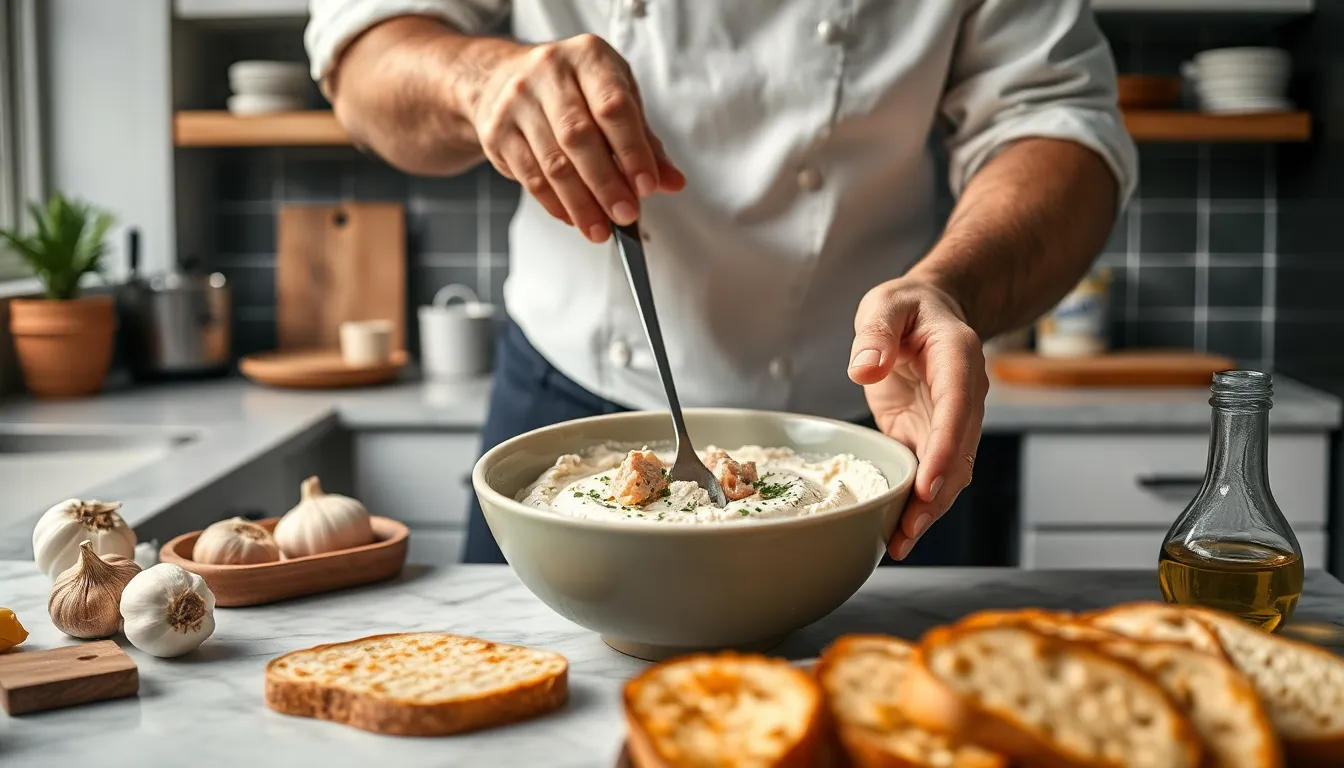
We’re bringing you a sophisticated French classic that transforms smoked cod into an elegant, creamy dip perfect for special occasions.
Traditional French Preparation Methods
Brandade de Morue originates from Provence as a beloved comfort dish that requires careful attention to detail. Salt cod forms the foundation of this classic recipe, though it demands patience since the fish must soak in water for up to 24 hours with multiple water changes to remove excess salt.
Once properly rehydrated, we simmer the cod gently rather than boiling it to maintain its delicate texture. The cooking process should never reach a vigorous boil since this toughens the fish and compromises the final dish’s smoothness.
Shredding the cooked cod finely creates the perfect base for emulsification. We gradually incorporate olive oil while continuously mixing to achieve the signature creamy consistency. Fresh garlic adds aromatic depth, while cream or milk provides additional richness that makes brandade irresistibly smooth.
Traditional purists prefer cod alone to maintain authentic flavor profiles, though many recipes include mashed potatoes for extra body. Serving brandade hot alongside toasted bread or crostini allows guests to enjoy this Mediterranean delicacy at its peak. The dish remains especially popular in Marseille and throughout southern France, where it’s considered the ultimate comfort food appetizer.
Modern Twists on the Classic Recipe
Contemporary chefs have revolutionized brandade by substituting smoked fish varieties like trout for traditional salt cod. This adaptation eliminates the lengthy soaking process entirely since smoked fish comes already preserved and perfectly seasoned.
Smoked trout brandade delivers the same luxurious texture as the original while introducing subtle smoky notes that enhance the overall flavor profile. We still combine the fish with olive oil, garlic, and cream or potatoes using identical emulsification techniques.
Preparation time drops significantly with smoked fish since there’s no desalting required. The smoked varieties flake beautifully and blend seamlessly with the traditional ingredients, creating an indulgent dip that’s both convenient and sophisticated.
Other smoked fish options include salmon, mackerel, or whitefish, each bringing unique flavor characteristics to this versatile recipe. These modern variations maintain brandade’s essence while offering home cooks flexibility and reduced preparation time without sacrificing the dish’s elegant appeal.
Smoked Salmon Quiche with Fresh Herbs
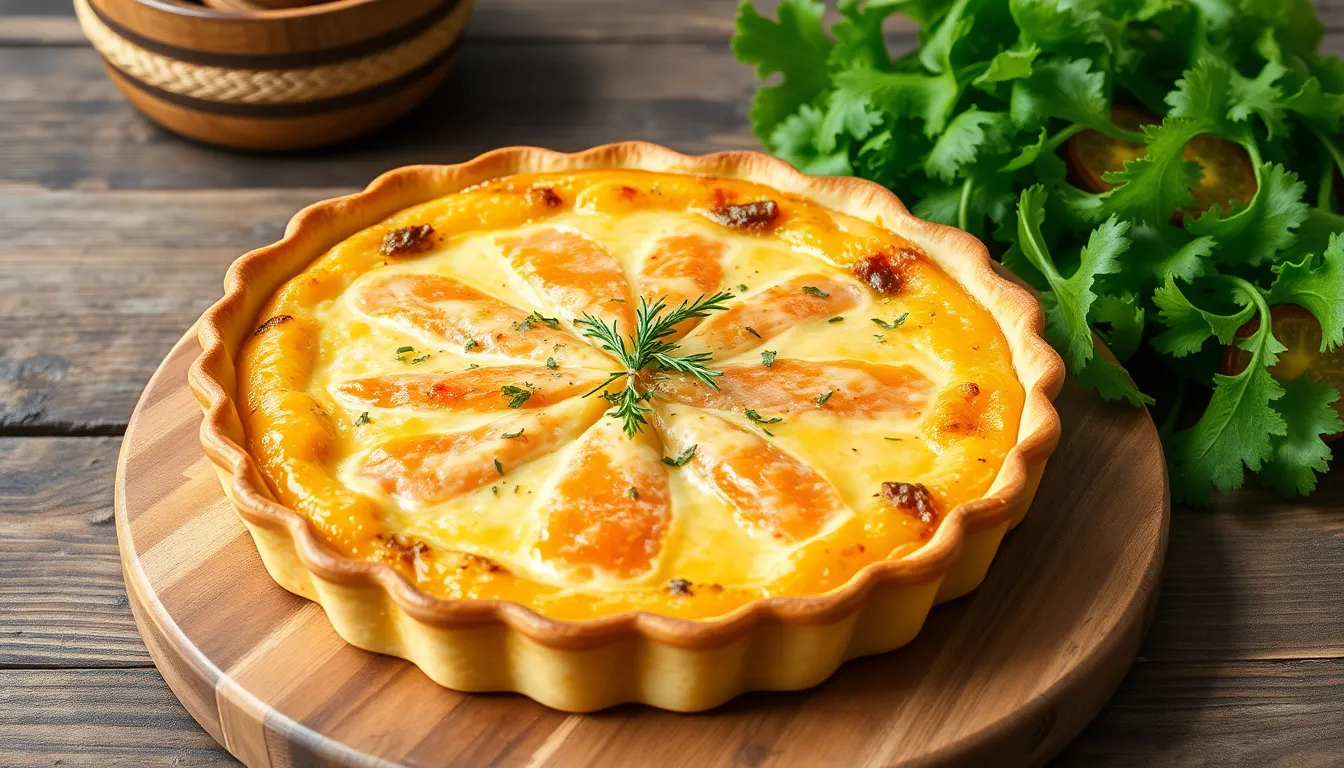
We’re elevating our smoked fish repertoire with this elegant French-inspired quiche that combines rich smoked salmon with aromatic herbs in a silky custard base. This sophisticated dish transforms simple ingredients into a restaurant-quality meal perfect for brunch entertaining or special occasions.
Perfect Pastry Crust Techniques
Building the foundation starts with combining 250g all-purpose flour, 1 teaspoon sea salt, and 1 teaspoon white sugar in a large mixing bowl. Cold unsalted butter (125g) gets cut into the flour mixture until it resembles coarse breadcrumbs for optimal texture. Whisking together 1 large beaten egg and 2 teaspoons Dijon mustard creates the binding liquid that transforms the mixture into smooth dough.
Chilling the dough before rolling prevents shrinkage and ensures easier handling during the shaping process. Rolling the pastry to exactly 2mm thickness provides the perfect balance between structure and tenderness. We line our 20cm quiche dish carefully, then trim excess pastry by rolling a pin directly over the dish edge for clean, professional-looking results.
Blind baking at 190°C for 10 minutes with baking weights or parchment paper prevents the bottom from puffing up. Removing the weights and baking an additional 2 minutes creates a crisp, dry base that won’t become soggy when filled with custard.
Custard Base and Baking Tips
Creating the perfect custard begins with whisking 4 large eggs and 300ml crème fraîche until completely smooth and lump-free. Adding ½ teaspoon sea salt, 1 crushed garlic clove, and 1 teaspoon paprika powder builds layers of savory flavor throughout the mixture. Fresh parsley (1 bunch finely chopped) and 3 finely sliced spring onions contribute bright herbal notes that complement the smoky salmon beautifully.
Pouring the custard mixture into our pre-baked pastry shell ensures even distribution without air bubbles. Arranging 200g of smoked salmon strips evenly across the surface prevents overcrowding while ensuring every slice contains the perfect amount of fish. Seasoning with freshly ground black pepper adds the final flavor accent before baking.
Baking at 180°C for approximately 40 minutes allows the custard to set gradually without curdling or overcooking. We know it’s perfectly done when the center feels just set to the touch and the surface shows a light golden color. Letting the quiche cool for 10-15 minutes before serving allows the custard to firm up for clean, beautiful slices that pair wonderfully with a crisp green salad.
Smoked Fish Sandwich Spreads

Moving beyond dips and elegant appetizers, we can transform smoked fish into delicious sandwich spreads that bring restaurant quality flavors to everyday meals. These creamy, flavorful spreads offer endless possibilities for quick lunches and satisfying snacks.
Three Versatile Base Recipes
Mayonnaise and Cream Cheese Base creates the most popular foundation for smoked fish spreads. We whisk together mayonnaise with softened cream cheese, then fold in chopped parsley, diced red onion, celery, lemon juice, Dijon mustard, horseradish, hot sauce, Worcestershire sauce, and Old Bay seasoning. Finely chopped smoked fish gets folded into this rich mixture, creating a classic smoked fish dip that works perfectly as a sandwich spread when chilled.
Mayonnaise and Sour Cream with Horseradish delivers a tangy, slightly spicy profile that complements smoked trout beautifully. Mix mayonnaise and sour cream in equal parts, then add freshly grated horseradish for heat. Fold in flakes or chunks of smoked trout to create a creamy base that’s ideal for hearty sandwiches.
Mascarpone and Butter with Horseradish offers a luxurious option for grilled cheese style sandwiches. Combine mascarpone cheese with softened butter and horseradish to create a rich, peppery spread. This base works exceptionally well with smoked fish and fruit combinations like pears, adding creamy richness that complements smoky flavors perfectly.
Bread Selection and Assembly
Brioche buns provide the perfect soft, slightly sweet foundation for BLT style smoked trout sandwiches. Toast the brioche lightly, spread habanero mayonnaise, then layer leaf lettuce, tomato slices, smoked trout fillets, crispy bacon, and avocado slices for a gourmet twist on the classic sandwich.
Sourdough bread excels in grilled cheese applications with smoked fish. Butter the sourdough slices, spread mascarpone and horseradish mixture, layer sliced pears and smoked trout chunks, add fresh dill, then grill until golden. The tangy sourdough provides a sturdy base that crisps beautifully when toasted.
Simple toasted bread slices work wonderfully for open faced sandwiches. Spread cream cheese generously on the toast, add your choice of smoked fish, then top with radish slices and fresh Italian parsley sprigs. This elegant presentation showcases the fish while keeping preparation simple and quick.
Conclusion
We’ve shared our favorite smoked fish recipes that’ll transform your kitchen into a gourmet destination. From simple spreads to sophisticated entrées these dishes prove that restaurant-quality meals are within everyone’s reach.
Each recipe we’ve covered offers endless possibilities for customization. Whether you’re hosting an elegant dinner party or preparing a quick weekday lunch these smoked fish creations adapt beautifully to any occasion.
The beauty of cooking with smoked fish lies in its convenience and bold flavors. We encourage you to experiment with different varieties and techniques to discover your own signature dishes. Your culinary adventures with smoked fish are just beginning.
Frequently Asked Questions
What types of smoked fish work best for cooking?
The most popular smoked fish for cooking include salmon, trout, mackerel, haddock, whitefish, and cod. Salmon is ideal for bagels and pasta dishes, while trout works excellently in salads. Mackerel is perfect for pâtés, haddock shines in chowders, and whitefish makes great dips and spreads.
How do I prevent smoked fish from becoming tough when cooking?
The key is timing and gentle heat. Add smoked fish toward the end of cooking to preserve its tender texture. For dishes like chowder or pasta, incorporate the fish during the last few minutes. Avoid high heat and overcooking, which can make the fish rubbery.
What’s the difference between hot and cold smoked fish?
Cold smoked fish is cured at low temperatures (under 90°F) and has a silky, raw-like texture perfect for bagels and salads. Hot smoked fish is cooked at higher temperatures (above 120°F) and has a flaky, cooked texture ideal for chowders, dips, and fish cakes.
Can I substitute different types of smoked fish in recipes?
Yes, most smoked fish can be substituted for one another, though flavors will vary. Mild fish like trout and whitefish work interchangeably in salads and dips. Stronger fish like mackerel and salmon can replace each other in pâtés and pasta dishes. Adjust seasonings accordingly.
How long can I store smoked fish dishes?
Fresh smoked fish dishes should be consumed within 2-3 days when refrigerated. Cooked dishes like chowders and quiches can last 3-4 days refrigerated. Fish cakes and pâtés typically keep for 2-3 days. Always store covered and check for any off odors before consuming.
What are the best bread options for smoked fish sandwiches?
Brioche buns work perfectly for BLT-style smoked fish sandwiches, while sourdough is excellent for grilled applications. Everything bagels are classic with smoked salmon, and toasted baguettes complement pâtés beautifully. Choose breads that won’t overpower the delicate fish flavors.
How do I make smoked fish dips smooth and creamy?
Process half the smoked fish until completely smooth while leaving some chunks for texture. Use room temperature cream cheese or mascarpone as your base, and add small amounts of mayonnaise or Greek yogurt. Incorporate liquid ingredients gradually to achieve the perfect consistency.
What herbs and seasonings pair best with smoked fish?
Dill is the classic pairing, especially with salmon and trout. Fresh chives, parsley, and capers add brightness. Horseradish provides heat that complements rich, oily fish. Lemon juice and zest enhance all smoked fish dishes, while black pepper and mustard add depth.

